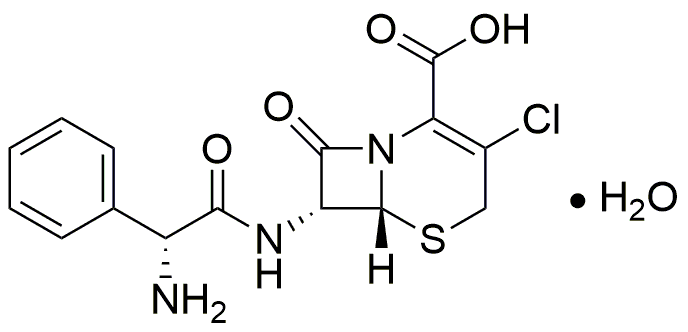Cefaclor monohydrate is widely utilized in research focused on:
- Antibiotic Development: This compound is primarily used in the pharmaceutical industry for developing antibiotics, particularly for treating bacterial infections. Its effectiveness against a range of gram-positive and some gram-negative bacteria makes it a valuable asset in drug formulation.
- Clinical Research: Cefaclor monohydrate is often employed in clinical trials to evaluate its efficacy and safety in treating respiratory tract infections, skin infections, and urinary tract infections, providing critical data for healthcare professionals.
- Pharmaceutical Manufacturing: The compound is essential in the production of oral antibiotics, allowing manufacturers to create effective treatments that are easy for patients to administer, thus improving compliance and health outcomes.
- Veterinary Medicine: Cefaclor monohydrate is also used in veterinary applications to treat infections in animals, ensuring that pets and livestock receive effective care, which is crucial for animal health and productivity.
- Research on Resistance Patterns: Researchers utilize this compound to study antibiotic resistance mechanisms in bacteria, helping to inform the development of new antibiotics and strategies to combat resistant strains.
General Information
Properties
Safety and Regulations
Applications
Cefaclor monohydrate is widely utilized in research focused on:
- Antibiotic Development: This compound is primarily used in the pharmaceutical industry for developing antibiotics, particularly for treating bacterial infections. Its effectiveness against a range of gram-positive and some gram-negative bacteria makes it a valuable asset in drug formulation.
- Clinical Research: Cefaclor monohydrate is often employed in clinical trials to evaluate its efficacy and safety in treating respiratory tract infections, skin infections, and urinary tract infections, providing critical data for healthcare professionals.
- Pharmaceutical Manufacturing: The compound is essential in the production of oral antibiotics, allowing manufacturers to create effective treatments that are easy for patients to administer, thus improving compliance and health outcomes.
- Veterinary Medicine: Cefaclor monohydrate is also used in veterinary applications to treat infections in animals, ensuring that pets and livestock receive effective care, which is crucial for animal health and productivity.
- Research on Resistance Patterns: Researchers utilize this compound to study antibiotic resistance mechanisms in bacteria, helping to inform the development of new antibiotics and strategies to combat resistant strains.
Documents
Safety Data Sheets (SDS)
The SDS provides comprehensive safety information on handling, storage, and disposal of the product.
Product Specification (PS)
The PS provides a comprehensive breakdown of the product’s properties, including chemical composition, physical state, purity, and storage requirements. It also details acceptable quality ranges and the product's intended applications.
Certificates of Analysis (COA)
Search for Certificates of Analysis (COA) by entering the products Lot Number. Lot and Batch Numbers can be found on a product’s label following the words ‘Lot’ or ‘Batch’.
*Catalog Number
*Lot Number
Certificates Of Origin (COO)
This COO confirms the country where the product was manufactured, and also details the materials and components used in it and whether it is derived from natural, synthetic, or other specific sources. This certificate may be required for customs, trade, and regulatory compliance.
*Catalog Number
*Lot Number
Safety Data Sheets (SDS)
The SDS provides comprehensive safety information on handling, storage, and disposal of the product.
DownloadProduct Specification (PS)
The PS provides a comprehensive breakdown of the product’s properties, including chemical composition, physical state, purity, and storage requirements. It also details acceptable quality ranges and the product's intended applications.
DownloadCertificates of Analysis (COA)
Search for Certificates of Analysis (COA) by entering the products Lot Number. Lot and Batch Numbers can be found on a product’s label following the words ‘Lot’ or ‘Batch’.
*Catalog Number
*Lot Number
Certificates Of Origin (COO)
This COO confirms the country where the product was manufactured, and also details the materials and components used in it and whether it is derived from natural, synthetic, or other specific sources. This certificate may be required for customs, trade, and regulatory compliance.


